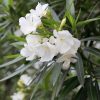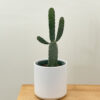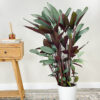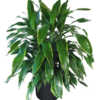Description
RADIANT PINK BLOOMS FLOURISH WITH MINIMAL MAINTENANCEThe Barbara Karst Bougainvillea tree can grow up to 30 ft. tall. Year round, you’ll enjoy its white flowers surrounded by bright red bracts. Durable, frost resistant, and ever so hardy, these trees grow in several temperature zones and will even tolerate cold climates.Should your garden plan call for something a bit more “wild,” you may want to choose The Barbara Karst Bougainvillea vine. It will climb up and over just about anything – including the side of your house. The vine also looks magnificent in a hanging basket. Yes, the possibilities seem endless.Caring for your BougainvilleaAdaptable to different soil types, it thrives best in well-draining soil. Barbara Karst Bougainvillea is drought-tolerant once established, making it an excellent choice for arid climates or water-wise landscapes. Despite its vigorous growth, it can be easily maintained through regular pruning. This captivating plant can be trained to grow onto trellises, arbors, or used as a striking ground cover, making it a versatile addition to any garden. Furthermore, its high heat tolerance and vibrant color make it a standout choice for adding a tropical feel to any landscape.LightBougainvilleas prefer a full sun position. A spot that gets at least six hours of direct sunlight is ideal for this sun-loving tropical plant. Too little sun will result in fewer flowers. They can tolerate light shade but may not flower as profusely.SoilThese plants prefer well-draining soil. They don’t like to have ‘wet feet’—overly damp conditions can lead to root rot, which is a common problem with Bougainvilleas. If you’re planting them in the garden, prepare the soil by adding some sand or fine grit to improve drainage. If planting in pots, ensure there are adequate drainage holes and consider adding a layer of pebbles or broken pot shards at the bottom to facilitate better water drainage.WaterBougainvilleas have a reputation for being drought tolerant once established. They prefer a thorough watering followed by a period of drying out. Allow the top few inches of soil to dry out before watering again. Overwatering can lead to a weak plant with fewer flowers and a potential for root diseases.FertilizingWhile Bougainvilleas are not overly fussy about their soil, feeding them with a fertilizer high in potassium can help boost their flowering potential. Avoid fertilizers high in nitrogen as this can promote leaf growth over flowers. The best time to fertilize is in early spring or just before the blooming season.PruningRegular pruning can keep a Bougainvillea plant tidy, promote lush growth, and encourage more blooms. They typically bloom on new growth, so pruning encourages the plant to produce new flowering shoots. The best time to prune a Bougainvillea is in early spring after the last chance of frost but before the plant has fully leafed out.Bougainvilleas can be trained as a vine to climb over pergolas and arches, or as a standard or bush with appropriate staking and pruning. If growing as a vine, ensure to provide a sturdy structure for the plant to climb.Pests and DiseasesBougainvilleas are relatively pest-resistant. However, they can sometimes be troubled by aphids, mealybugs, or caterpillars. If an infestation is noticed, an appropriate pesticide or insecticidal soap can be applied.





